Abstract
Numerous waterborne outbreaks of giardiasis have occurred since 1965, yet little or no information has been reported on the viability of Giardia cysts in different aquatic environments. We have studied the viability of Giardia muris cysts suspended in lake, river, and tap water, while also monitoring water temperature, dissolved oxygen, pH, and other water quality parameters. Fecal pellets containing G. muris cysts were placed in glass vials covered with filter paper and exposed to (i) lake water at 15 ft (ca. 4.6 m) and 30 ft (ca. 9.2 m), (ii) river water, (iii) tap water, and (iv) distilled water stored under laboratory conditions. At 3, 7, 14, 28, 56, and 84 days, two vials from each environment were removed, and cyst viability was determined by (i) fluorogenic dye exclusion, (ii) production of giardiasis in an animal, and (iii) cyst morphology by Nomarski microscopy. In the fall, the cysts suspended at 30 ft in lake water remained viable for up to 56 days whereas cysts stored at 15 ft were nonviable after day 28. The G. muris cysts exposed to river water remained viable up to 28 days as determined by the production of giardiasis in mice. G. muris cysts suspended in tap water showed no signs of viability after 14 days, while cysts serving as controls (exposed to refrigerated distilled water) remained viable for up to 56 days. In the winter, Giardia cysts suspended in either lake or river water were viable for 56 to 84 days whereas cysts exposed to tap water were nonviable by day 14.(ABSTRACT TRUNCATED AT 250 WORDS)
Full text
PDF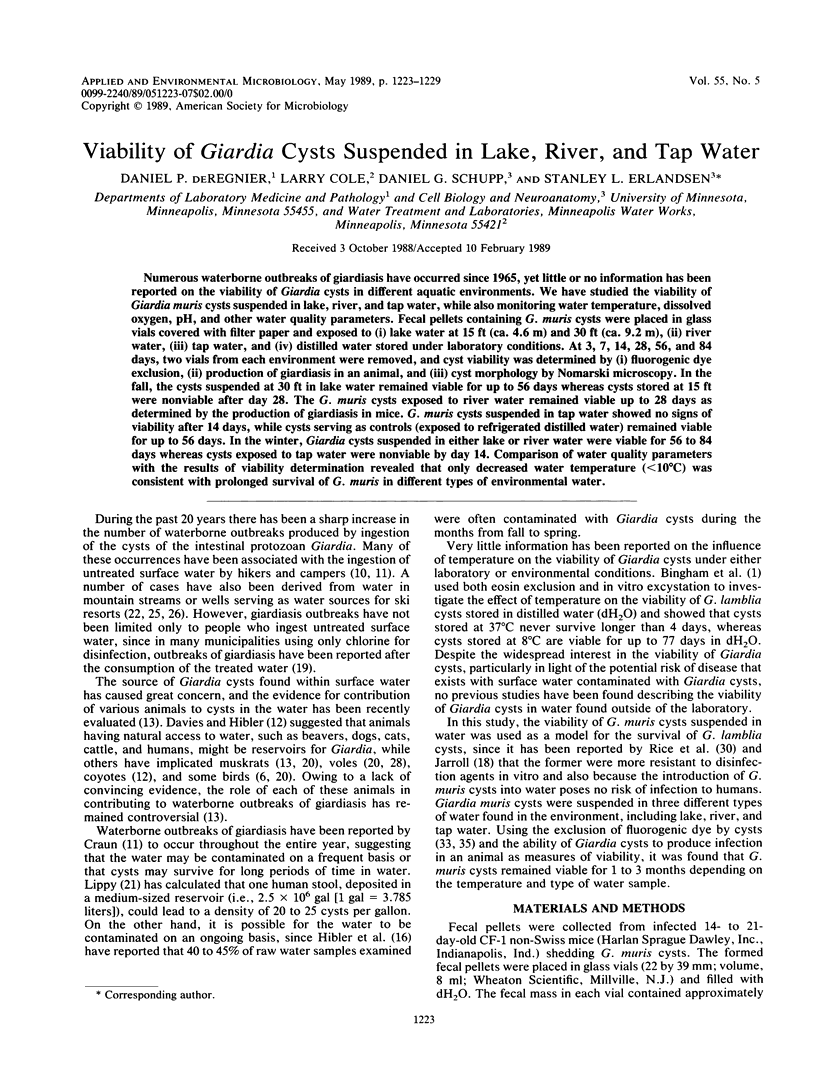
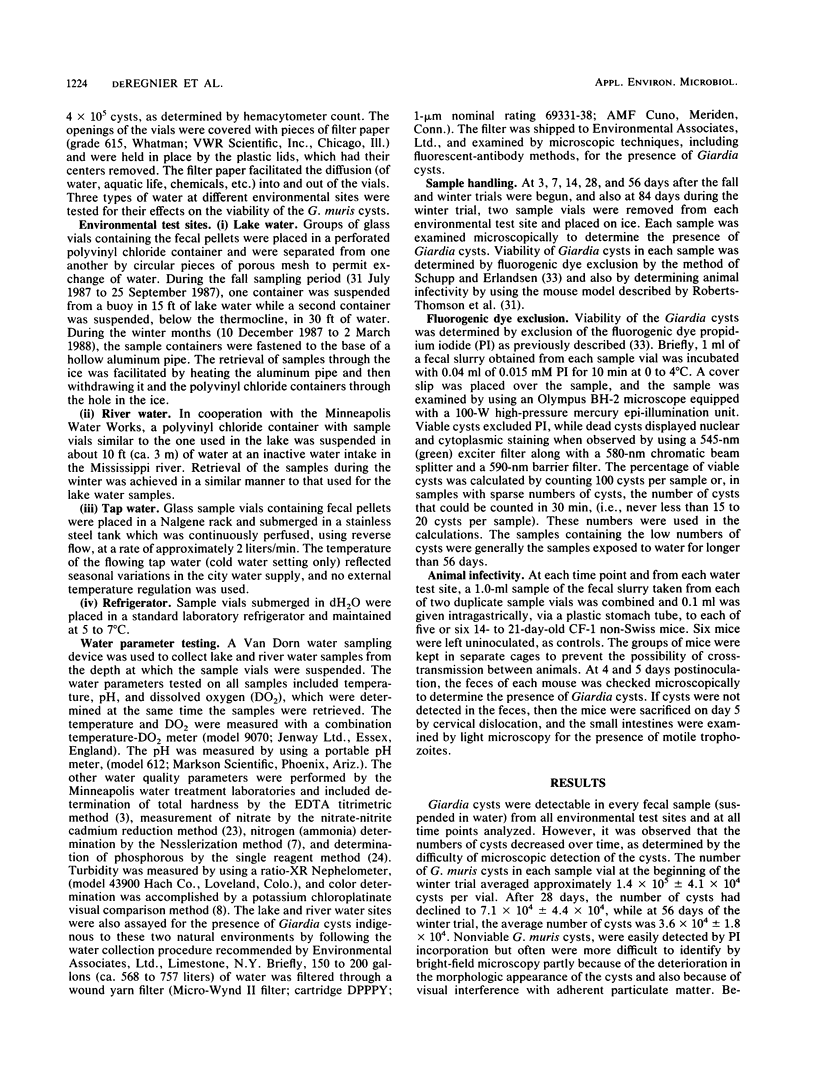
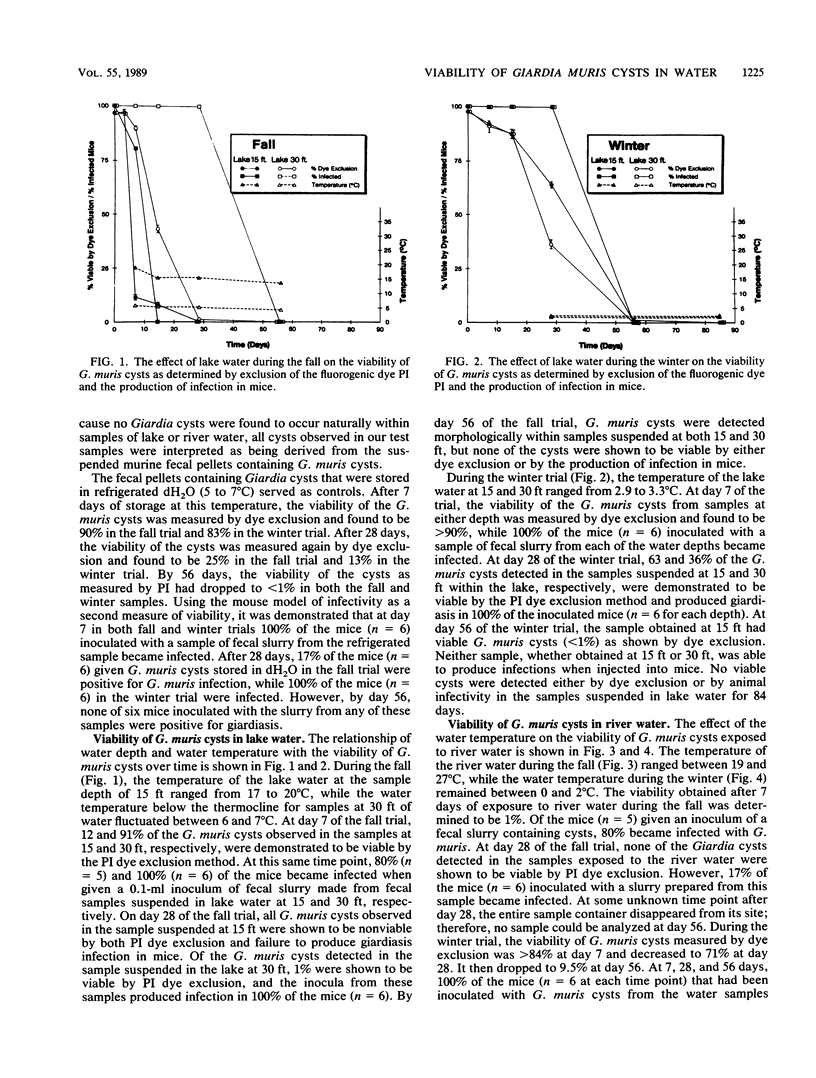
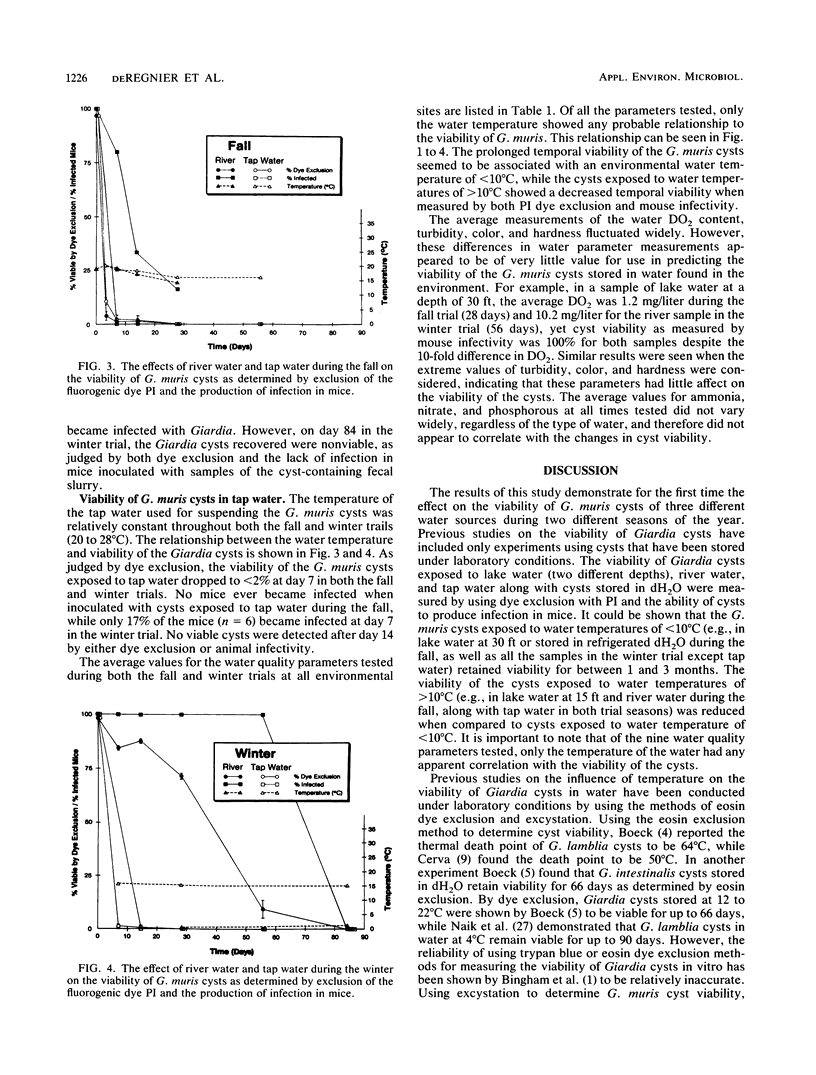
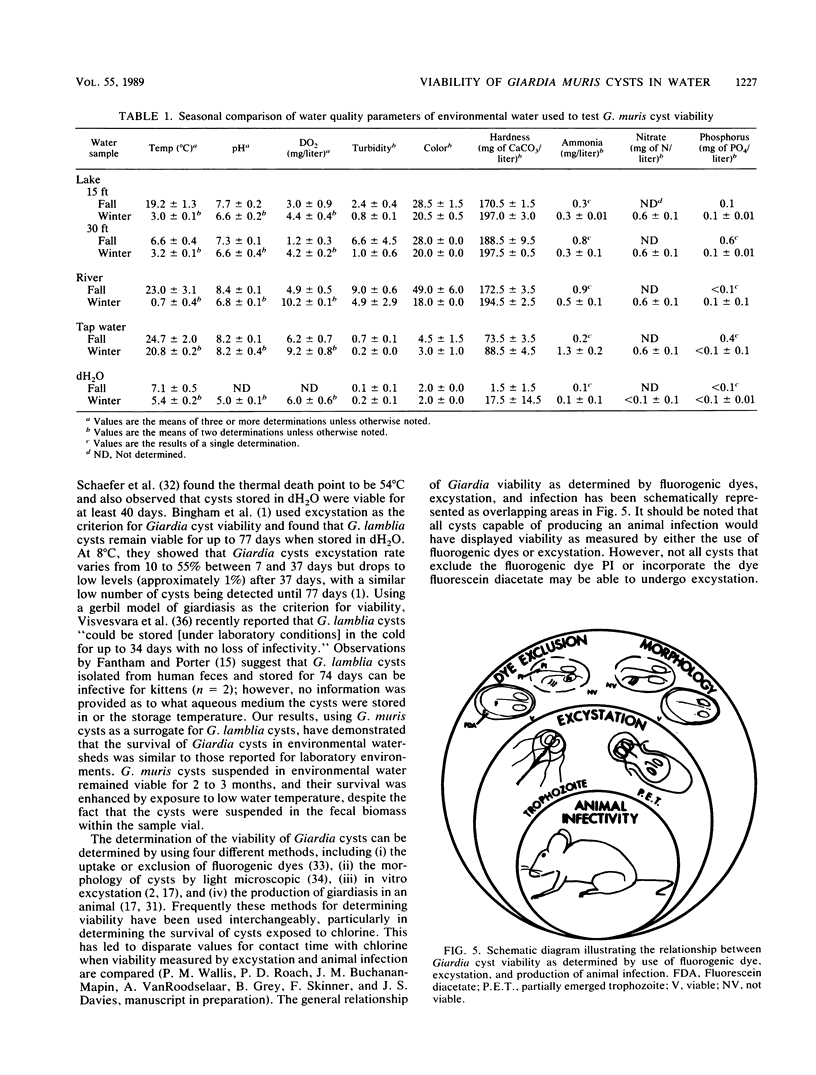
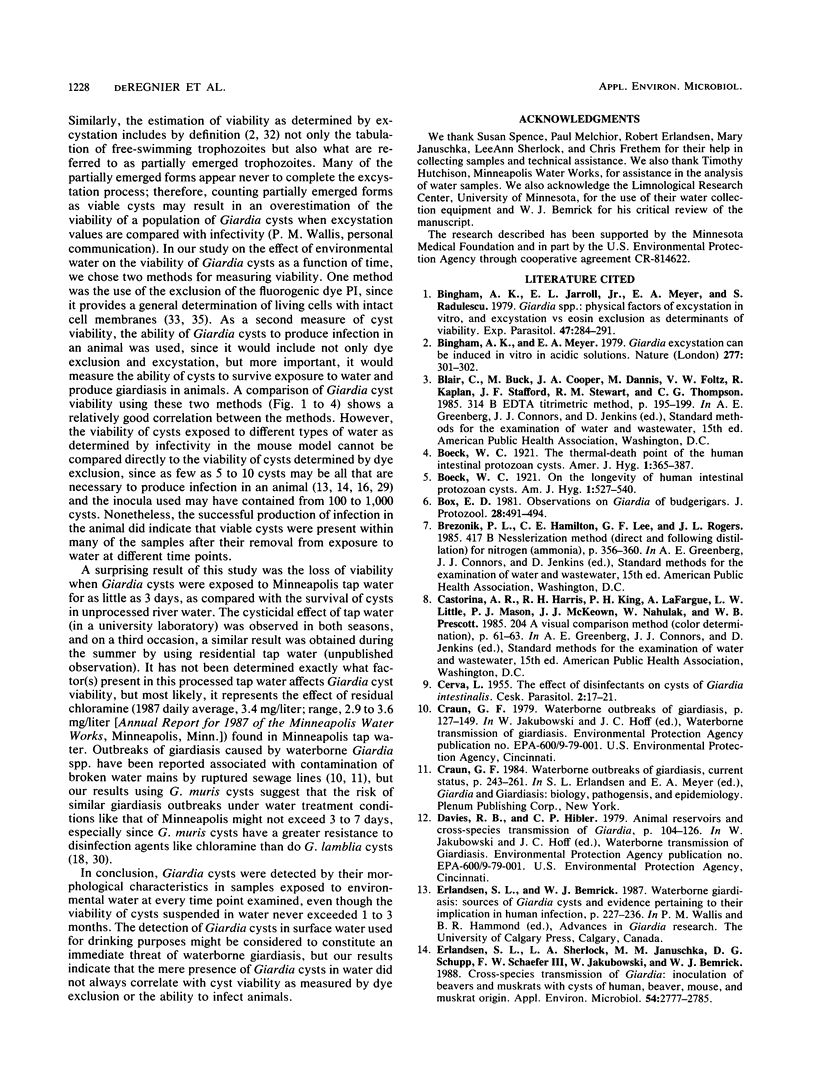
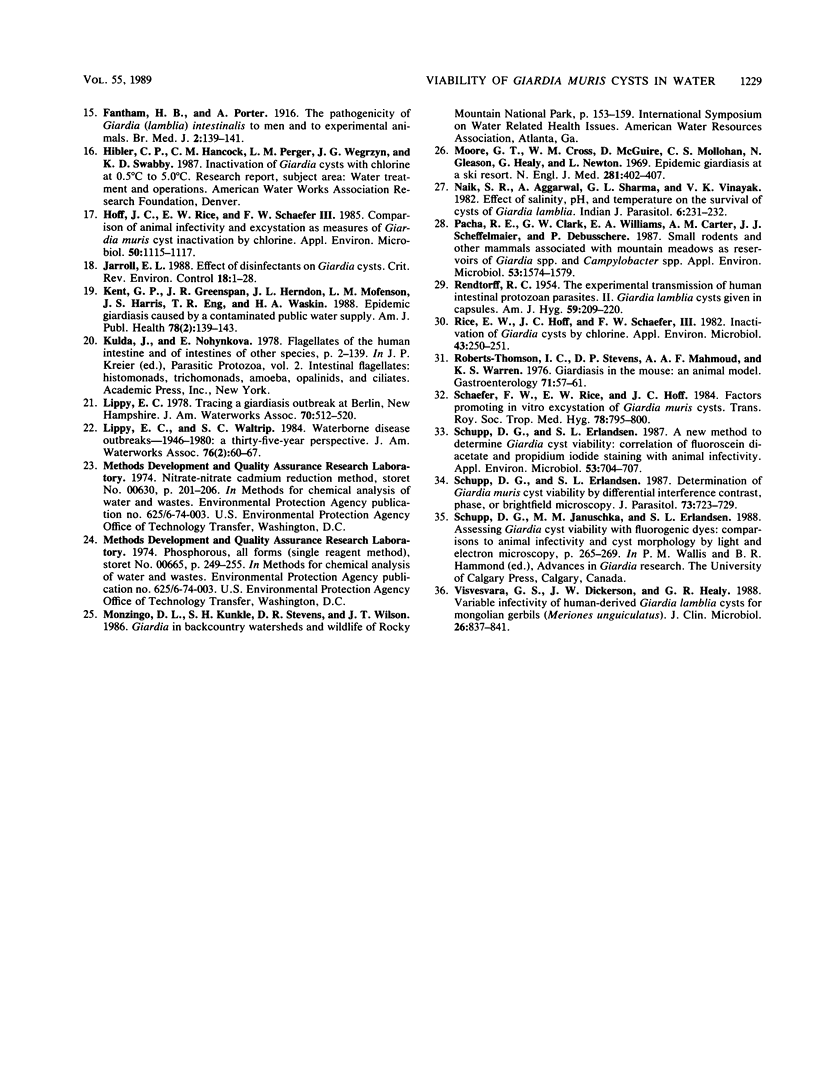
Selected References
These references are in PubMed. This may not be the complete list of references from this article.
- Bingham A. K., Jarroll E. L., Jr, Meyer E. A., Radulescu S. Giardia sp.: physical factors of excystation in vitro, and excystation vs eosin exclusion as determinants of viability. Exp Parasitol. 1979 Apr;47(2):284–291. doi: 10.1016/0014-4894(79)90080-8. [DOI] [PubMed] [Google Scholar]
- Bingham A. K., Meyer E. A. Giardia excystation can be induced in vitro in acidic solutions. Nature. 1979 Jan 25;277(5694):301–302. doi: 10.1038/277301a0. [DOI] [PubMed] [Google Scholar]
- Box E. D. Observations on Giardia of budgerigars. J Protozool. 1981 Nov;28(4):491–494. doi: 10.1111/j.1550-7408.1981.tb05326.x. [DOI] [PubMed] [Google Scholar]
- Erlandsen S. L., Sherlock L. A., Januschka M., Schupp D. G., Schaefer F. W., 3rd, Jakubowski W., Bemrick W. J. Cross-species transmission of Giardia spp.: inoculation of beavers and muskrats with cysts of human, beaver, mouse, and muskrat origin. Appl Environ Microbiol. 1988 Nov;54(11):2777–2785. doi: 10.1128/aem.54.11.2777-2785.1988. [DOI] [PMC free article] [PubMed] [Google Scholar]
- Hoff J. C., Rice E. W., Schaefer F. W., 3rd Comparison of animal infectivity and excystation as measures of Giardia muris cyst inactivation by chlorine. Appl Environ Microbiol. 1985 Oct;50(4):1115–1117. doi: 10.1128/aem.50.4.1115-1117.1985. [DOI] [PMC free article] [PubMed] [Google Scholar]
- Kent G. P., Greenspan J. R., Herndon J. L., Mofenson L. M., Harris J. A., Eng T. R., Waskin H. A. Epidemic giardiasis caused by a contaminated public water supply. Am J Public Health. 1988 Feb;78(2):139–143. doi: 10.2105/ajph.78.2.139. [DOI] [PMC free article] [PubMed] [Google Scholar]
- Moore G. T., Cross W. M., McGuire D., Mollohan C. S., Gleason N. N., Healy G. R., Newton L. H. Epidemic giardiasis at a ski resort. N Engl J Med. 1969 Aug 21;281(8):402–407. doi: 10.1056/NEJM196908212810802. [DOI] [PubMed] [Google Scholar]
- Pacha R. E., Clark G. W., Williams E. A., Carter A. M., Scheffelmaier J. J., Debusschere P. Small rodents and other mammals associated with mountain meadows as reservoirs of Giardia spp. and Campylobacter spp. Appl Environ Microbiol. 1987 Jul;53(7):1574–1579. doi: 10.1128/aem.53.7.1574-1579.1987. [DOI] [PMC free article] [PubMed] [Google Scholar]
- RENDTORFF R. C. The experimental transmission of human intestinal protozoan parasites. II. Giardia lamblia cysts given in capsules. Am J Hyg. 1954 Mar;59(2):209–220. doi: 10.1093/oxfordjournals.aje.a119634. [DOI] [PubMed] [Google Scholar]
- Rice E. W., Hoff J. C., Schaefer F. W., 3rd Inactivation of Giardia cysts by chlorine. Appl Environ Microbiol. 1982 Jan;43(1):250–251. doi: 10.1128/aem.43.1.250-251.1982. [DOI] [PMC free article] [PubMed] [Google Scholar]
- Roberts-Thomson I. C., Stevens D. P., Mahmoud A. A., Warren K. S. Giardiasis in the mouse: an animal model. Gastroenterology. 1976 Jul;71(1):57–61. [PubMed] [Google Scholar]
- Schaefer F. W., 3rd, Rice E. W., Hoff J. C. Factors promoting in vitro excystation of Giardia muris cysts. Trans R Soc Trop Med Hyg. 1984;78(6):795–800. doi: 10.1016/0035-9203(84)90024-5. [DOI] [PubMed] [Google Scholar]
- Schupp D. G., Erlandsen S. L. A new method to determine Giardia cyst viability: correlation of fluorescein diacetate and propidium iodide staining with animal infectivity. Appl Environ Microbiol. 1987 Apr;53(4):704–707. doi: 10.1128/aem.53.4.704-707.1987. [DOI] [PMC free article] [PubMed] [Google Scholar]
- Schupp D. G., Erlandsen S. L. Determination of Giardia muris cyst viability by differential interference contrast, phase, or brightfield microscopy. J Parasitol. 1987 Aug;73(4):723–729. [PubMed] [Google Scholar]
- Visvesvara G. S., Dickerson J. W., Healy G. R. Variable infectivity of human-derived Giardia lamblia cysts for Mongolian gerbils (Meriones unguiculatus). J Clin Microbiol. 1988 May;26(5):837–841. doi: 10.1128/jcm.26.5.837-841.1988. [DOI] [PMC free article] [PubMed] [Google Scholar]


